This article discusses the how prestressed precast concrete planks are constructed, specified and installed.
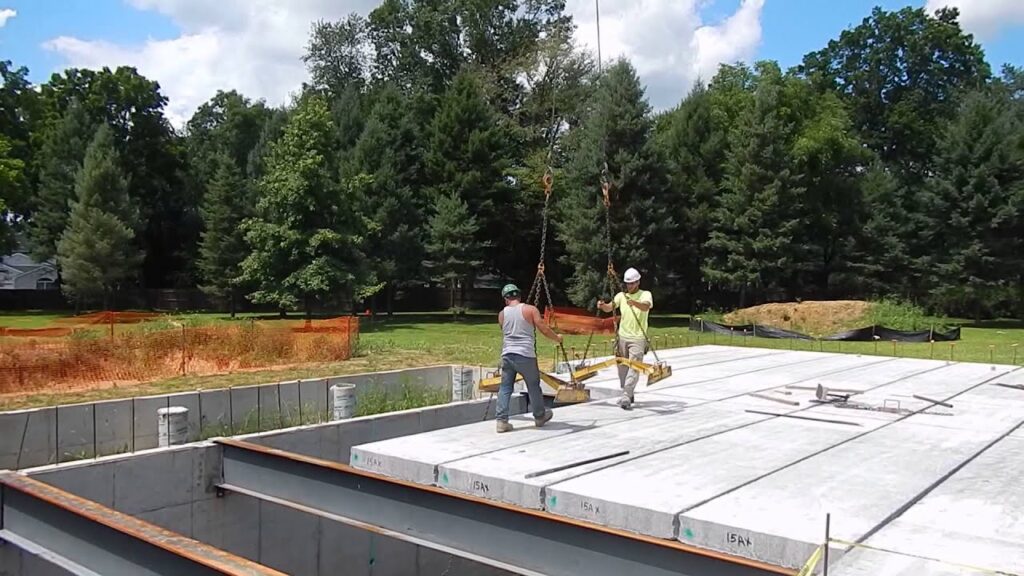
Precast concrete planks are a common method of floor slab construction. They are installed quickly and create a safe and solid floor surface to work from as soon as they are put into place. At domestic scale they may be chosen as the flooring solution with masonry construction because of their fire and acoustic separation attributes as well as contributing to thermal mass. At commercial scales they off er longer spanning capabilities than concrete on permanent metal decking and, with appropriate cranage, enable faster floor construction than cast in-place solutions.
This article outlines the construction, specifications, and installation procedures for prestressed precast concrete planks. It is important to note that the design process is intricate and not covered here. It will be addressed in a forthcoming article.
In a factory setting, manufacturers produce precast concrete planks with predetermined depths typically ranging from 110mm to 400mm in thickness. The specific thickness may vary among manufacturers, but all fall within this specified range. Hollow cores contribute to their lighter weight compared to on-site equivalents. The shape of these cores depends on the thickness of the plank (refer to Figure 1). The planks are generally manufactured in widths not exceeding 1200mm and undergo prestressing through a series of strands situated in the lower section. Consequently, they lack the ability to cantilever unless additional reinforcement is introduced into the upper section to counteract tension forces generated by the hogging bending moment.
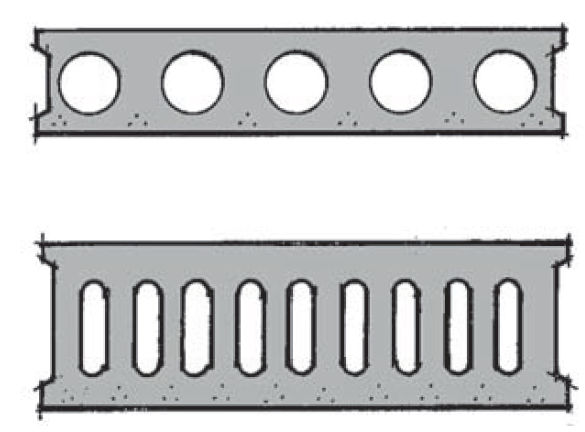
The planks’ soffit quality holds significance as it is frequently exposed, thereby influencing the visual appeal. The predetermined quality of the planks is a result of the factory conditions in which they are manufactured, allowing the design team to assess it before specification. Given the exposed nature of the planks, the joints between them become visible. In such cases, it is crucial to give special consideration to how these joints affect the overall aesthetics.
Specifying Thickness
The manufacturer usually undertakes the design of precast concrete planks, and any modifications to the design during construction should be communicated to them. The structural engineer overseeing the overall structure design can estimate the depth of precast concrete planks by utilizing a load table provided by the manufacturer. An illustration of such design data is presented in Table 1, enabling an estimation of a dead load of 1.5 kN/m2 for finishes.
Composite Precast Concrete Planks
Planks commonly collaborate with a layer of reinforced concrete, a practice referred to as ‘structural topping,’ typically measuring 75mm in thickness. This addition strengthens the planks, establishing a necessary diaphragm within the slab for most structures. The reinforcement in the structural topping must be designed to accommodate both diaphragm and bending actions, acting as a tie force within the floor structure, as detailed in Clause 10.9.3 of BS EN 1992-1-1.
It’s essential to distinguish the structural topping from a screed. While the former contributes structural enhancements to precast concrete planks, the latter serves as a finishing layer without adding any structural benefits. A section through a composite precast concrete plank is illustrated in Figure 2.
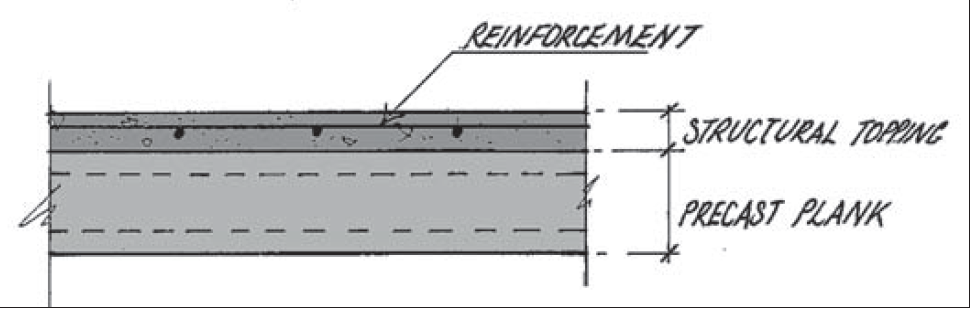
Detailing for precast concrete planks
Ensuring the successful incorporation of precast concrete planks in a structure hinge on the installation of sufficient bearing to support them. If the primary structure lacks proper detailing to meet this requirement, the planks cannot be installed, risking shear failure at the support point. Planks with specific characteristics, such as depth, heavy loading, exposure to thermal variations, or reliance on relatively flexible supports, require particular attention in this regard.
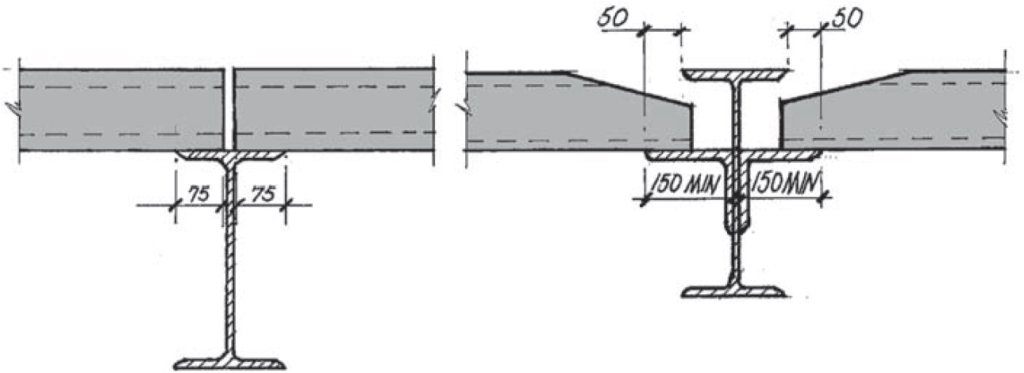
The required width of a bearing depends on the type of material supporting the precast concrete plank. For both steelwork and concrete, the minimum required bearing width is 75mm, while for masonry, it is 100mm. However, if the manufacturer and installer find tighter tolerances acceptable, reduced widths can be considered. For instance, providing sufficient bearing for two hollow-core planks on a 140mm flange is achievable. Detailed rules regarding this are outlined in Clause 10.9.5.2 of BE EN 1992-1-1. Figures 3 and 4 illustrate typical support details for precast concrete planks on various materials. It is advisable to verify all bearing requirements for precast concrete planks with the manufacturer.
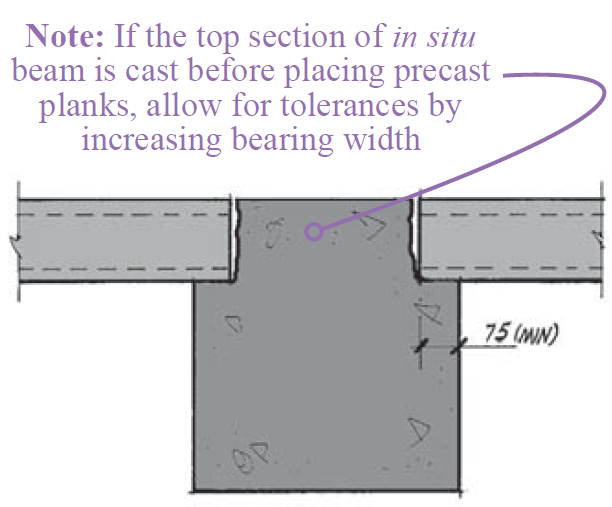
In terms of robustness of the overall structure, it is important to ensure the planks are tied to the supporting structure as well as elements that provide lateral stability, such as shear walls. More detail on this subject can be found in the Institution of Structural Engineers’ Practical guide to structural robustness and disproportionate collapse in buildings.
It is crucial to highlight a significant consideration in the installation of precast concrete planks onto steelwork, particularly concerning stability. The potential for instability arises when unbalanced loads are applied to the beam, especially in the case of longer-spanning beams. To address this concern, it is advisable to alternate the placement of planks on both sides of the beam, preventing the supporting beam from becoming unstable. Additional information on this topic is available in the guidance note on Lateral Torsional Buckling from the Institution of Structural Engineers.
Precast concrete planks exhibit a distinctive characteristic known as pre-camber along their span, forming a bow during the pre-stressing of the reinforcing tendons cast into the plank. This pre-camber results in a non-flat floor slab, typically necessitating the application of a finish for leveling purposes. In composite precast concrete planks, the average depth is 75mm, increasing at the point of support and decreasing at the apex of the pre-camber.
Various factors influence the extent of camber within a plank. However, it is customary to account for a pre-camber equal to span/300. It is important to note that when a plank spans transversely to a bearing supporting other planks, a step in the floor surface will occur. This consideration becomes significant when placing sheet insulation atop the floor, potentially requiring the inclusion of a nominal thickness screed. Figure 6 elucidates how the pre-camber impacts the structural topping.

Also See: Concrete Slabs in Concrete Frame Buildings
Sources & Citation
- Precast Flooring Federation (2005) Hollow-core Floors (Datasheet) Leicester, UK: Precast Flooring Federation Precast Flooring Federation (2008) Code of Practice: For the Safe Erection of
- Precast Concrete Flooring and Associated Components Leicester, UK: Precast Flooring Federation
- The Institution of Structural Engineers (2013) Precast Concrete Planks,(Technical Guidance Note 24 (Level 1). London, UK: The Institution of Structural Engineers
